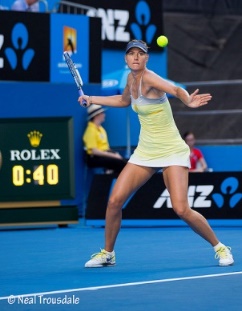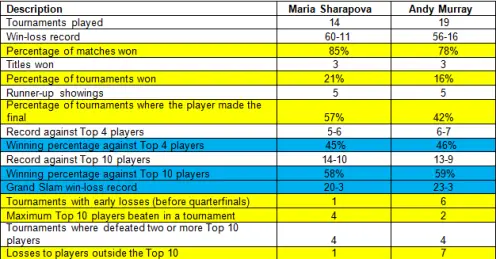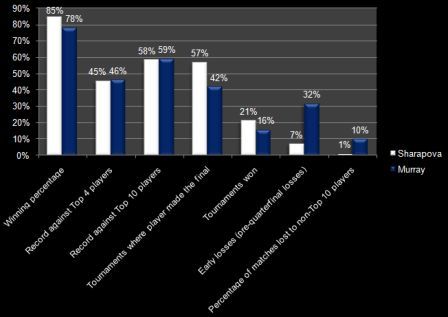This is the third post in Omair‘s series comparing the games of WTA Top 3 to their respective Top 3 ATP colleagues. After the introductory article, Omair talked about “Who would win if Serena faced Djokovic, Azarenka played Federer and Sharapova encountered Murray?” and now he is digging into the actual stats to compare them further.


It is always tough when you have to compare the consistency of players, there are a lot of factors that must be taken into account. I tried to cover some factors and see how the two players respond in each of the chosen categories. I would love to hear from you people and see if we can add further categories to enhance the analysis and make it more credible.
The factors that I have taken into account are as follows:
- WIN-LOSS RECORD – Gives an idea of how many matches the player actually played and how many matches he/she won or lost. This will also be important in that we will see if a player won more matches than the other despite playing fewer tournaments.
- PERCENTAGE OF MATCHES WON – Players have played different number of tournaments, hence just comparing the number of matches won or lost would not make sense. A more appropriate indicator for comparison will be the percentage of matches won or lost. The greater the percentage, the more consistent the player is, and vice versa.
- PERCENTAGE OF TITLES WON – I have mentioned the number of titles won in the summary, but more appropriate would be the percentage of titles won, since each player played different number of tournaments, hence percentage will give us a better idea of which player did well. The greater the percentage, the more consistent the player is, and vice versa.
- PERCENTAGE OF TOURNAMENTS WHERE THE PLAYER REACHED THE FINAL – This again is an important indicator of the consistency of the player, and the reason of taking the percentage, rather than absolute number is the same as explained above. The greater the percentage is, the more consistent the player is, and vice versa.
- PERCENTAGE OF MATCHES WON AGAINST THE TOP 4 PLAYERS
- PERCENTAGE OF MATCHES WON AGAINST TOP 10 PLAYERS – For the record of a player against the Top 4 players and the Top 10 players, I have mentioned the win-loss record to give you an indication of actual matches won-lost against the Top 4 and Top 10 players, but again percentage will be a better indicator for the same reasons explained above. The greater the percentage, the more consistent the player is, and vice versa.
- PERCENTAGE OF TOURNAMENTS WITH EARLY LOSSES – Early loss means a loss before the quarterfinal stage of the tournament. I have indicated the number of tournaments where the player lost before the quarterfinal stage, but again as explained above, percentage gives us a better picture of the consistency and makes more sense of the comparison. The lesser the percentage, the more consistent the player is, and vice versa.
- GRAND SLAM WIN-LOSS RECORD – This has been presented as a whole number since this can be compared as a whole number considering all the players in question played all the four Grand Slams.
- MAXIMUM TOP 10 PLAYERS BEATEN IN A TOURNAMENT – In my point of view this is also one of the most important indicators of the consistency of the player. This shows the level at which you can consistently beat the top players.
- PERCENTAGE OF MATCHES LOST AGAINST PLAYERS OUTSIDE THE TOP 10 – I have taken this factor into consideration, since it will tell us whether the player has won the matches he/she was supposed to win. This will indicate how often the top player has lost to players outside the Top 10 and hence been less consistent. The lesser the percentage, the more consistent the player is, and vice versa.
The 12-month period begins with Dubai (ATP) last year and ends with Dubai (WTA) this year. I have not accounted for Dubai-ATP this year, since when I started the series Dubai had not started yet.
Having established the time span and the factors which we will take into account for determining the consistency, let us start with comparing the results of Maria Sharapova with that of Andy Murray.
The summary of their results over the course of last 12 months is as follows (rows highlighted in yellow go in favor of Sharapova and the ones highlighted in blue favor Murray):

It is interesting to note that Sharapova won four more matches than Murray, despite playing five fewer tournaments.
There are quite a few categories where Sharapova has the edge over Murray: she won more matches, more tournaments and made the final of more tournaments. Sharapova lost before the quarterfinals of only one tournament, while Murray lost early in six tournaments. Sharapova beat four Top 10 players in a single tournament, while Murray took out two Top 10 players in a tournament.
However, quite a few important ones go in Murray’s favor as well. He won more matches against the Top 4 and Top 10 players as compared to Sharapova, his Grand Slam record is better than Sharapova’s.
Let us see how some of the important factors look when presented graphically:

The case for Andy Murray can be made by saying that he won the Olympic Gold Medal by beating world No.1 and No.2 players and he made three Grand Slam finals and won one Grand Slam.
However, for Maria Sharapova it can be said that she won more matches as compared to Andy Murray, despite having played five fewer tournaments, and she completed her Career Grand Slam by winning Roland Garros. She beat four top players in a tournament (year-end Championships, although she ended up being a runner-up), she lost just one match to a player ranked outside the Top 10, while Murray lost seven matches.
This is something very subjective, but if we want to draw an overall conclusion, my vote will be for Maria Sharapova as being the more consistent player through the course of last 12 months based on the following factors:
- She reached the quarterfinals or better of all tournaments she played with the exception of one, while Murray failed to reach the quarterfinals in six tournaments.
- Of the 11 matches Sharapova lost, only one loss was to a player ranked outside the Top 10, and that too came at the hands of then ranked No.15 Sabine Lisicki in the fourth round of Wimbledon. Murray, on the other hand, lost seven times to players not ranked in the Top 10, his worst loss being at the hands of then 92nd-ranked Guillermo Garcia-Lopez, in the second round of Indian Wells in straight sets.
- Sharapova beat four Top 10 players in a single tournament, while Murray did not beat more than two Top 10 players in a single tournament.
- Sharapova made the finals of more than 50% of tournaments she played (57%), as compared to 42% by Andy Murray.
Most of you will be wondering why I did not consider Murray’s higher win-loss percentage record against the Top 4 and Top 10 players while making the decision. I did take it into account, but given the marginal advantage of Murray over Sharapova in those categories, I had to give Sharapova the edge based on her substantial edge over Murray in the points discussed above.
How do you see the results of these players in comparison to each other? Who do you think has been more consistent as compared to the other player?
Stay tuned, comparisons of Serena Williams with Novak Djokovic and Victoria Azarenka against Roger Federer are coming. (photos: © Neal Trousdale)





Interesting, esp. the metrics used for determining consistency …
Hows the comparison look like if we were to also compare win/loss records against?:
1. Top 5 players
2. Top 20 players
3. Top 30/50 players
Since its consistency we are looking at, perhaps that will also add some weight into determining it?
Well Murray has won the Olympic Games and the US Open, while Maria has not reached the OL gold medal. I think Murray was more consistent playing a really good tennis for a long time now.
First off, I love this concept! Obviously Murray would destroy Sharapova in a head to head match but I like comparing the top men and women by statistics. I agree that Sharapova has been better on her respective tour. Murray’s post Australian Open until Wimbledon was pretty subpar for his standards. However, Sharapova wasn’t able to win any of her biggest matches against Vika/Serena, whereas Murray beat Federer and Djokovic in big events.
Interesting comparison that i have not seen before. Have to give the nod to Murray for his strong and consistent play against the two dominating players in the world last year, Novak and Fed.
As much as I like Maria, she failed miserably against the top players Vika and Serena.. Not only did she lose to them, she lost very badly.
Thanks Kartik. It can be done and will of course provide more insight into determining the consistency. I will try to divide the win-loss in the categories you have mentioned in the final article of the series.
Tennis Blog – Yes, Murray won Gold medal and U.S Open, Sharapova won silver medal and French Open. Sharapova’s results over the course of 12 months have been more consistent as compared to Murray. She won 4 more matches than Murray despite playing 5 fewer tournaments.
Very interesting article – I like how you’re trying to keep the view balanced between the ATP and the WTA instead of leaping to conclusions right away.
I’d have to side with Sharapova here as Murray, in spite of having his Slam breakthrough last year, still tends to be quite up and down in his results and was mediocre at best in almost all tournaments outside of the Slams/Olympics. Sharapova, in contrast, was extremely consistent and failed to make the QFs of a tournament only once; she might have lost more easily to the two players ranked above her than Murray did, but she was more reliable than him at defeating lower-ranked opponents which I think matters more in terms of consistency.
I do not think you evaluated consistency. You evaluated the quality of the player (how good results (s)he had). Since there are 3 top women while 4 top man it is not much surprising that Sharapova looks better.
The consistency is the variation of results – absolutely consistent is a player either winning everything or loosing everything. It might be measured by a standard deviation of rounds reached in tournaments. A care should be taken to consider touyrnaments with various numbers of rounds (e.g., the rounds should be counted from the last), and very likely only top level tournaments should be considered (e.g. mandatory) to avoid differences in the quality of the draw.
Murray is more like a survivor ….his last match was very very bad, as if he wasn’t on court …Sharapova…well she’s ok but not in her best condition…